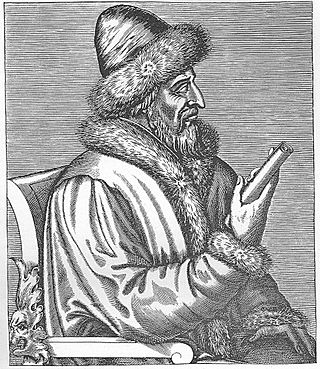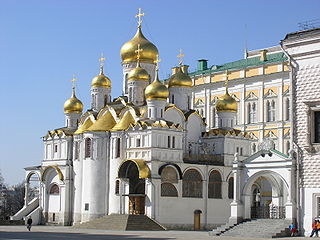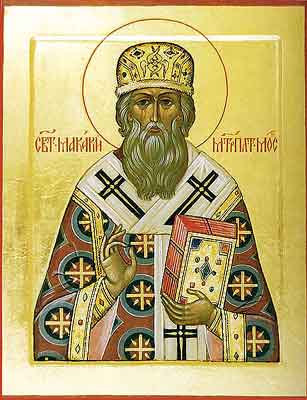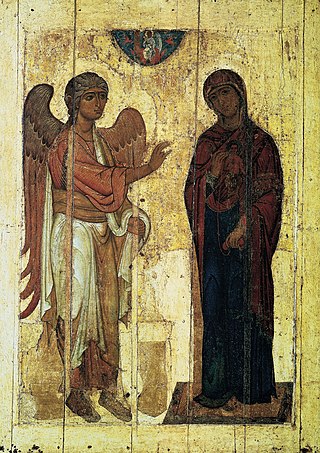
Ivan IV Vasilyevich, commonly known as Ivan the Terrible, was Grand Prince of Moscow and all Russia from 1533 to 1547, and the first Tsar and Grand Prince of all Russia from 1547 until his death in 1584. Ivan's reign was characterised by Russia's transformation from a medieval state to an empire, but at an immense cost to its people and long-term economy.

Ivan III Vasilyevich, also known as Ivan the Great, was Grand Prince of Moscow and all Russia from 1462 until his death in 1505. Ivan served as the co-ruler and regent for his blind father Vasily II before he officially ascended the throne.

Vasili III Ivanovich was Grand Prince of Moscow and all Russia from 1505 until his death in 1533. He was the son of Ivan III and Sophia Paleologue and was christened with the name Gavriil (Гавриил). Following on the ambitions of his predecessor Ivan, Vasili conquered Pskov, Ryazan and Smolensk as well as strengthening Russian influence in Kazan and to the Volga region. Several nobles were either exiled, sentenced or executed for criticizing his policies.

The Moscow Kremlin or simply the Kremlin is a fortified complex in Moscow, Russia. Located in the centre of the country's capital city, it is the best known of the kremlins and includes five palaces, four cathedrals, and the enclosing Kremlin Wall along with the Kremlin towers. Within the complex is the Grand Kremlin Palace, which served as the royal residence of the Emperor of Russia. It is now the official residence of the President of the Russian Federation. The Kremlin overlooks the Moskva River to the south, Saint Basil's Cathedral and Red Square to the east, and Alexander Garden to the west.

The Cathedral of the Dormition, also known as the Assumption Cathedral or Cathedral of the Assumption, is a Russian Orthodox church dedicated to the Dormition of the Theotokos. It is located on the north side of Cathedral Square of the Moscow Kremlin in Russia, where a narrow alley separates the north from the Patriarch's Palace with the Twelve Apostles Church. Separately in the southwest, also separated by a narrow passage from the church, stands the Palace of Facets. The cathedral is regarded as the mother church of Muscovite Russia.

The Palace of the Facets is a building in the Moscow Kremlin, Russia, which contains what used to be the main banquet reception hall of the Russian tsars. It is the oldest preserved secular building in Moscow. Located on Kremlin Cathedral Square, between the Cathedral of the Annunciation and the Dormition Cathedral. Currently, it is an official ceremonial hall in the residence of the President of the Russian Federation and thus admission is limited to prearranged tours only.

Sophia Fominichna Palaiologina or Paleologue was a Byzantine princess from the Palaiologos imperial dynasty and the grand princess of Moscow as the second wife of Ivan III of Russia. Her father was Thomas Palaiologos, the despot of the Morea. Through her eldest son, Vasili III, she was the grandmother of Ivan IV, the first crowned tsar of all Russia.

Job, also known as Job of Moscow, was the first Patriarch of Moscow and All Russia. He is venerated as a saint by the Russian Orthodox Church. He was the Metropolitan of Moscow and all Rus' from 1587 to 1589. He was the seventeenth Metropolitan in Moscow to be appointed without the approval of the Ecumenical Patriarch of Constantinople as had been the norm. In 1589, Jeremias II, the Patriarch of Constantinople, regularized Job's canonical status and raised him to the status of patriarch.

Michael Lvovich Glinsky was a noble from the Grand Duchy of Lithuania of distant Mongol extraction, who was also a tutor of his grand-nephew, Ivan the Terrible. Glinsky was born in Turov. He was a son of prince Lev Borisovich Glinsky, and paternal uncle of Elena Glinskaya. As a young man, Glinsky served in the court of Emperor Maximilian I and earned distinction for his military service. Around 1498 he returned to Lithuania and quickly rose in power and wealth, angering local nobles. Just after commanding the victorious Battle of Kletsk against the Crimean Khanate in August 1506, he was accused of conspiracy against the deceased Grand Duke Alexander Jagiellon and lost all his wealth. Glinsky began an armed rebellion against Sigismund I, the new Grand Duke. The rebellion was unsuccessful and Glinsky retreated to the Grand Duchy of Moscow, where he served Vasili III of Russia. When the Muscovite–Lithuanian Wars renewed in 1512, Glinsky was instrumental in helping Moscow to capture Smolensk, a major trading centre. However, he was not rewarded with the regency of the city. Angered, he planned to betray Vasili III, but the plot was discovered and he was imprisoned for 12 years. He was freed after his niece Elena Glinskaya, daughter of his brother Vasili Lvovich Glinsky and Ana Jakšić, married Vasili III in 1526. Before his death in 1533, Vasili appointed Elena as regent for his underage sons Ivan and Yuri. Elena disapproved of Glinsky's influence in state affairs and had him sent to prison, where he soon died of starvation.

The Cathedral of the Annunciation in Moscow is a Russian Orthodox church dedicated to the Annunciation of the Theotokos. It is located on the southwest side of Cathedral Square in the Moscow Kremlin in Russia, where it connects directly to the main building of the complex of the Grand Kremlin Palace, adjacent to the Palace of Facets. It was originally the personal chapel for the tsars, and its abbot remained a personal confessor of the Russian royal family until the early 20th century. Now it also serves as a part of Moscow Kremlin Museums.

Macarius was the Metropolitan of Moscow and all Rus' from 1542 until 1563. He was the tenth metropolitan in Moscow to be appointed without the approval of the Ecumenical Patriarch of Constantinople as had been the norm.
Athanasius was the Metropolitan of Moscow and all Rus' from March 1564 to May 1566. He was the eleventh metropolitan in Moscow to be appointed without the approval of the Ecumenical Patriarch of Constantinople as had been the norm.
Cyril IV was the Metropolitan of Moscow and all Rus' from 1568 to 1572. He was the fourteenth Metropolitan in Moscow to be appointed without the approval of the Ecumenical Patriarch of Constantinople as had been the norm.

Annunciation of Ustyug is a Russian Annunciation icon, created in Novgorod in the 12th century, and one of the few icons which survived the Mongol invasion of Rus'. The Annunciation of Ustyug is currently held in the Tretyakov Gallery. The origins of the icon and the exact date of its creation are disputed.

The Great Menaion Reader is the official Russian Orthodox menologium, i.e., a collection of biblical books with interpretations of exordiums, patericons, translated or original hagiographies of Russian saints, works of church fathers, and Russian ecclesiastical writers.

The coronation of the emperor of Russia from 1547 to 1917, was a highly developed religious ceremony in which they are crowned and invested with regalia, then anointed with chrism and formally blessed by the church to commence his reign. Although rulers of Muscovy had been crowned prior to the reign of Ivan III, their coronation rituals assumed overt Byzantine overtones as the result of the influence of Ivan's wife Sophia Paleologue, and the imperial ambitions of his grandson, Ivan the Terrible. The modern coronation, introducing "Western European-style" elements, replaced the previous "crowning" ceremony and was first used for Catherine I in 1724. Since tsarist Russia claimed to be the "Third Rome" and the replacement of Byzantium as the true Christian state, the Russian rite was designed to link its rulers and prerogatives to those of the so-called "Second Rome" (Constantinople).

The donkey walk is a Russian Orthodox Palm Sunday ritual re-enactment of Jesus Christ's entry into Jerusalem. The best known historical donkey walk was practised in Moscow from 1558 until 1693. The Metropolitan and later Patriarch of Moscow, representing Jesus Christ, rode on a donkey, while the Tsar of Russia humbly led the donkey on foot.

The Tale of the Princes of Vladimir is an early 16th-century Muscovite treatise which propounds the conception of Moscow as the Third Rome. It has been attributed either to Dmitry Gerasimov or Pachomius the Serb, among other learned monks.

Anna Glinskaya was a Serbian and Russian noblewoman. She was the daughter of Serbian voivode Stefan Jakšić from the Jakšić family. Her sister Jelena Jakšić was the titular despotissa of Serbia.

Moscow Kremlin Museums is a major state-run museum in Moscow Kremlin. Its roots lie in the Kremlin Armoury museum founded in 1806, the current form of the museum started in 1991. The Head of the museum is Yelena Gagarina, daughter of cosmonaut Yuri Gagarin. There were 424,922 visitors to the Kremlin Museums in 2020, a drop of 86 percent from 2019 due to the COVID-19 pandemic, but it still ranked 46th on the List of most-visited art museums in the world in 2020.


















